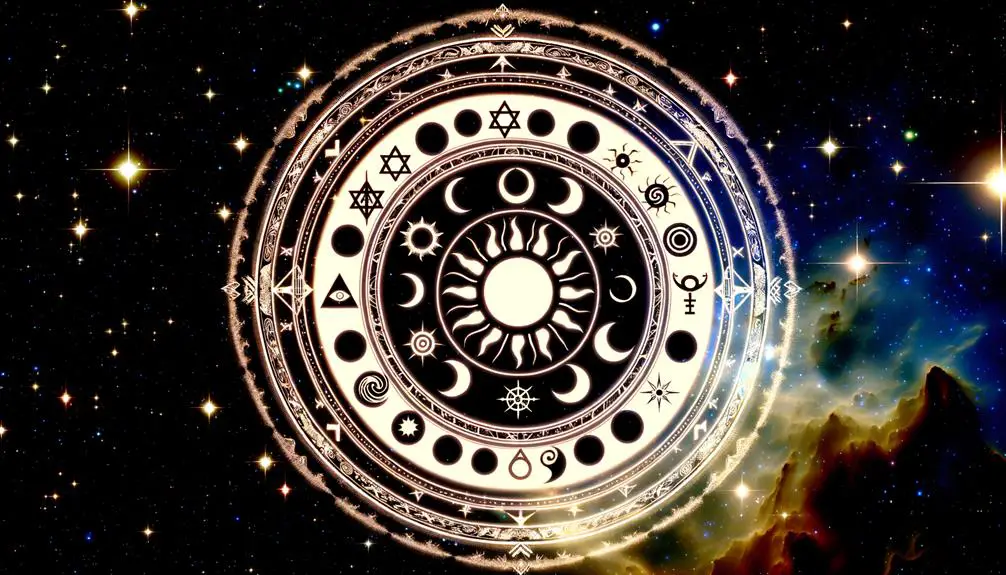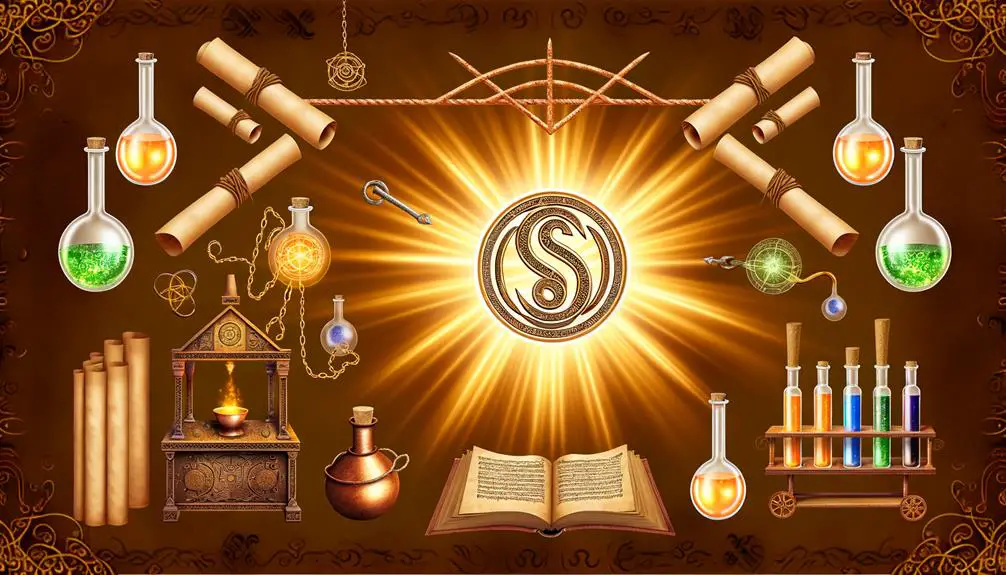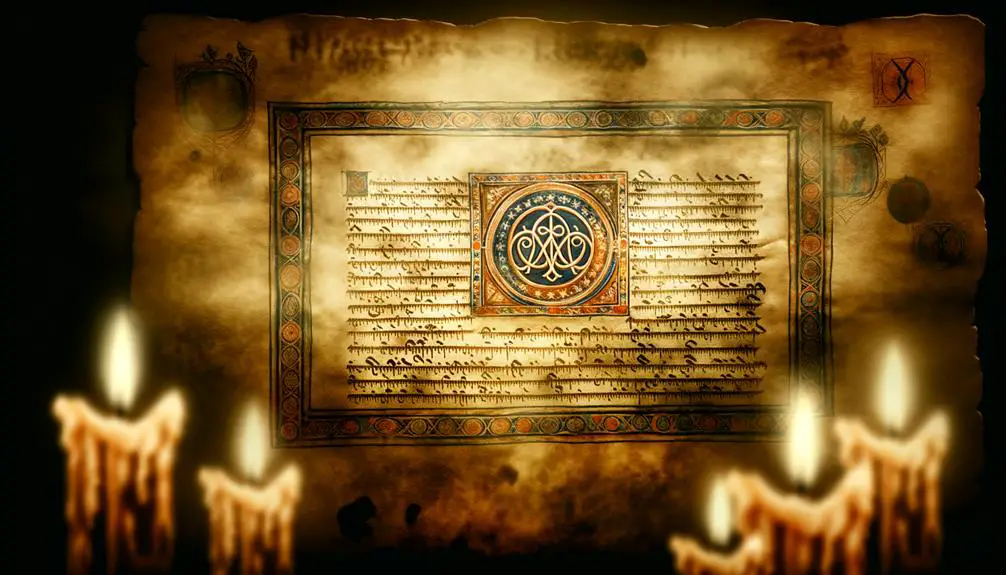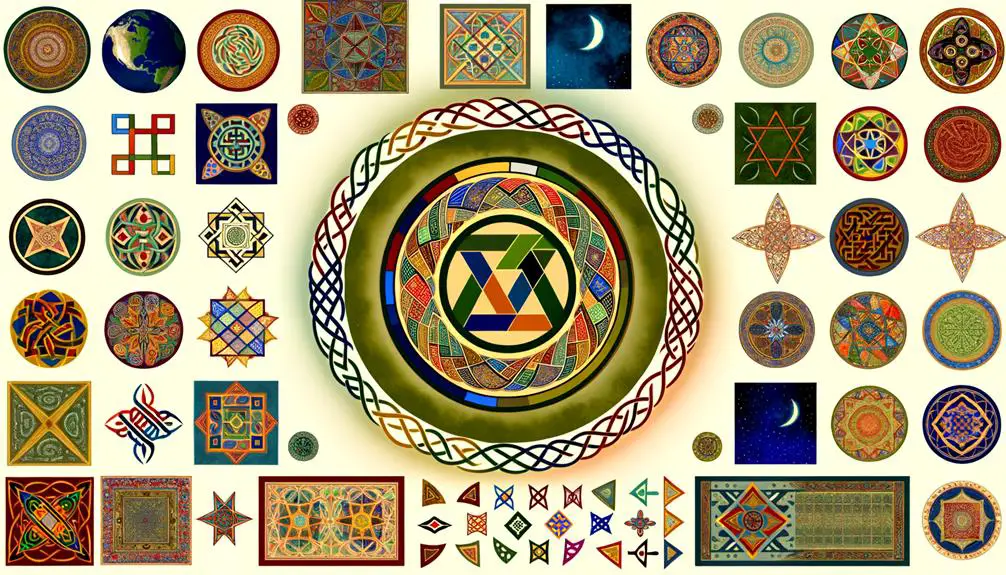How to Decode the Mystical Meaning of Solomon’s Seal Symbol
The Solomon's Seal symbol, often depicted as a hexagram or interlocking triangles, holds significant mystical and protective meanings across various cultural and religious traditions. Rooted in Judaic, Islamic, and medieval European histories, it is attributed to King Solomon's legendary wisdom and magical prowess.
In Jewish Kabbalah, it represents the interconnectedness of the ten sefirot, symbolizing divine attributes. Medieval alchemists saw it as emblematic of the unity of opposites in transformation processes.
Its protective qualities are prominent in occult practices and historical amulets. Discover more about its profound influence and integration in different esoteric and religious contexts.

Key Takeaways
- Represents divine union and the harmonious balance between the earthly and divine realms.
- Symbolizes protection against negative energies in various esoteric and mystical traditions.
- Embodies wisdom and the synthesis of knowledge, linked to King Solomon's legendary wisdom.
- Used in rituals and amulets for spiritual protection, invoking divine energy.
- Signifies unity of opposites and the pursuit of spiritual and material perfection in alchemy.
Origins of Solomon's Seal
Rooted in ancient mysticism and historical texts, the origins of Solomon's Seal can be traced back to a blend of Judaic, Islamic, and medieval European traditions that attribute the symbol to King Solomon's legendary wisdom and supposed magical prowess.
Ancient Judaic texts, including the Talmud, reference Solomon's Seal as possessing protective and authoritative powers. Islamic tradition, particularly within the Quran, also links the symbol to Solomon, emphasizing its use to command spirits and jinn.
Medieval European alchemy adopted the Seal into its mystical practices, integrating it into talismans and amulets.
This confluence of cultural narratives underscores the symbol's enduring legacy, reflecting an intricate tapestry of historical beliefs and practices that have shaped its significance over centuries.
Jewish Kabbalistic Significance
In the domain of Jewish Kabbalah, Solomon's Seal is intrinsically linked to the Tree of Life, symbolizing the interconnectedness of the ten sefirot that represent the attributes of God.
This emblem is also believed to possess mystical protective powers, serving as a talisman against malevolent forces.
Historical texts and Kabbalistic teachings provide substantial evidence of its usage in rituals and spiritual practices aimed at harnessing divine protection and wisdom.
Tree of Life Connection
The Solomon's Seal symbol is intricately connected to the Tree of Life in Jewish Kabbalistic tradition, where it is often interpreted as a representation of the harmonious balance between divine and earthly domains.
The Tree of Life, or Etz Chaim, comprises ten interconnected spheres known as Sephirot, which symbolize various aspects of God's creation and human experience.
The Solomon's Seal, with its interlocking triangles, mirrors this interconnectedness, embodying the unity and equilibrium between spiritual and material realities.
Kabbalists view the symbol as a geometric expression of the mystical ascent through the Sephirot, facilitating a deeper understanding of divine wisdom.
This connection underscores the profound spiritual insights that the Solomon's Seal offers within the Kabbalistic framework.
Mystical Protective Powers
Revered for its mystical protective powers, the Solomon's Seal symbol in Jewish Kabbalistic tradition is believed to ward off malevolent forces and attract divine favor, serving as a potent amulet for spiritual safeguarding.
Rooted in esoteric wisdom, the Seal comprises two interlocking triangles, symbolizing the harmony between the divine and earthly domains.
Historical texts, such as the Sefer Raziel HaMalakh, attribute the symbol with the ability to invoke angelic protection. It is often inscribed on talismans and utilized during rituals to create a sacred barrier against negative energies.
Detailed studies indicate its usage extends to enhancing prayer efficacy and spiritual insight, underscoring its esteemed role in Jewish mysticism.
Medieval Alchemy Connections

The Solomon's Seal, an emblem replete with esoteric symbolism, is intricately linked to medieval alchemy where it was believed to encapsulate profound truths about the cosmos.
Originating from ancient esoteric traditions, its geometric configuration was thought to symbolize the unity of opposites—a core principle in alchemical transformation practices aimed at achieving the philosopher's stone.
Historical texts from the medieval period frequently reference the symbol in the context of transmutation processes, underscoring its significance in the alchemical quest for both material and spiritual perfection.
Esoteric Symbolism Origins
In medieval alchemy, Solomon's Seal emerged as a potent symbol, intricately linked to the pursuit of esoteric knowledge and the transmutation of both matter and spirit. Its six-pointed star configuration, also known as the hexagram, was believed to encapsulate the unity of opposites—a fundamental principle in alchemical philosophy.
Alchemists saw it as representing the harmonious blend of elemental forces: fire and water, earth and air. This symbol, often inscribed in manuscripts and alchemical apparatus, served as a talisman of protection and divine wisdom.
Historical records indicate that the hexagram was employed in rituals aimed at achieving the Philosopher's Stone, a legendary substance purported to grant immortality and the ability to turn base metals into gold.
Alchemical Transformation Practices
Building upon the symbolic significance of Solomon's Seal, medieval alchemists meticulously developed transformation practices that sought to harness the hexagram's esoteric properties for achieving spiritual enlightenment and material transmutation.
The hexagram, viewed as a synthesis of opposites—such as fire and water—served as a potent emblem in the alchemical quest for the philosopher's stone. Alchemical texts like the 'Turba Philosophorum' elucidated the Seal's role in balancing elemental forces, fostering the alchemist's journey from base matter to purified gold.
These practices were not merely physical but deeply spiritual, aligning the practitioner's soul with cosmic harmony. Evidence from surviving manuscripts underscores the Seal's integral role, where its geometric precision was believed to mirror the divine order of the universe.
Symbolism in Occult Practices
Occult practices frequently employ the Solomon's Seal symbol, attributing to it profound esoteric significance grounded in historical texts and mystical traditions. This emblem, often associated with King Solomon, is believed to possess protective, magical, and divinatory properties. Its hexagram form, intersecting triangles, represents the union of opposites—spirit and matter, male and female, fire and water. Practitioners use this symbol in rituals, amulets, and talismans to invoke spiritual protection and balance.
| Element | Symbolism |
|---|---|
| Triangle Up | Fire, Spirit, Ascension |
| Triangle Down | Water, Matter, Descent |
| Intersecting | Unity of Opposites |
| Hexagram | Macrocosm, Divine Order |
| Usage | Protection, Invocation, Balance |
Such applications underscore the symbol's enduring relevance in the esoteric arts.
Comparisons to the Star of David
While the Solomon's Seal symbol holds significant meaning within occult practices, it is often compared to the Star of David due to their visually similar hexagram shapes and shared historical roots.
Both symbols consist of two interlocking triangles forming a six-pointed star, but they diverge in cultural and contextual significance. The Star of David, or Magen David, is chiefly associated with Judaism and represents divine protection and identity.
Conversely, Solomon's Seal is tied to esoteric traditions, symbolizing wisdom, protection, and the interplay of opposites. Historical texts suggest that while the Star of David gained prominence in Jewish communities around the Middle Ages, Solomon's Seal has deeper connections to alchemical and mystical lore, emphasizing its role in magical and protective rituals.
Solomon's Seal in Art
The Solomon's Seal has been an emblematic staple in various forms of art throughout history, serving as a profound symbol in religious art, where it often signifies divine wisdom and protection.
Historical artistic representations of the symbol can be traced back to medieval manuscripts and Islamic architecture, underscoring its wide-reaching cultural significance.
In contemporary times, modern artistic interpretations continue to evolve, utilizing the symbol in diverse mediums to explore themes of mysticism and interconnectedness.
Symbolism in Religious Art
In religious art, the Solomon's Seal, often depicted as a hexagram or two interlocking triangles, serves as a potent symbol of divine union, balance, and protection, deeply rooted in both Judaic and Christian iconography. This emblem is frequently incorporated into religious manuscripts, architectural designs, and ceremonial objects, signifying the interconnectedness of the earthly and the divine.
In Judaic tradition, it symbolizes the merger of God's justice and mercy, while in Christian contexts, it often represents the Holy Trinity's unity. The dual triangles also evoke the harmony between the material and spiritual domains. This multifaceted symbol consequently functions as a visual theology, encapsulating complex doctrinal concepts within a geometric framework, thereby enriching the spiritual narrative conveyed through religious art.
Historical Artistic Representations
Numerous historical artistic representations of the Solomon's Seal can be found across various cultures, each reflecting unique interpretations and styles that highlight its significance within different artistic and religious traditions.
In medieval Islamic art, the symbol often appeared on amulets and talismans, believed to offer protection and wisdom.
Byzantine mosaics frequently incorporated the Seal within religious iconography, symbolizing divine wisdom and celestial harmony.
Jewish manuscripts from the Middle Ages also featured the Seal prominently, often linked to King Solomon's legendary wisdom and authority.
Similarly, in Hindu and Buddhist traditions, the Seal appeared in mandalas, representing cosmic order and spiritual balance.
These diverse representations underscore the universal reverence for the Solomon's Seal as a potent symbol of wisdom, protection, and mystical power.
Modern Artistic Interpretations
Building on these historical foundations, contemporary artists continue to explore and reinterpret the Solomon's Seal, infusing it with fresh perspectives and modern symbolism. Artists such as Damien Hirst and Marina Abramović have integrated the symbol into their works, reflecting its enduring relevance.
Hirst's 'The Sacred Heart' series juxtaposes the Seal with anatomical imagery, suggesting a convergence of mysticism and science. Abramović's performance art, often invoking ritualistic elements, subtly incorporates the Seal to signify protection and spiritual exploration.
These modern interpretations highlight the symbol's adaptability, bridging ancient esoteric knowledge with today's artistic narratives. Consequently, the Solomon's Seal remains a potent emblem, continually evolving within the dynamic landscape of contemporary art.
Protective Qualities

The Solomon's Seal symbol, often associated with ancient mystical traditions, is reputed to offer potent protective qualities by warding off negative energies and malicious forces.
Historical texts and esoteric lore suggest that the symbol, with its interlocking triangles, creates a balanced harmonic field that can shield individuals from harmful influences.
Archaeological findings reveal that amulets and talismans bearing the Solomon's Seal were commonly used across various cultures for protection.
In Kabbalistic teachings, the symbol is considered a conduit for divine energy, creating a barrier against malevolent entities.
Contemporary practitioners of mysticism and spirituality continue to employ the Solomon's Seal in rituals and meditative practices, leveraging its reputed ability to provide both physical and metaphysical safeguarding.
Symbol of Wisdom
In addition to its protective qualities, the Solomon's Seal symbol is revered as a profound emblem of wisdom, embodying the synthesis of knowledge and insight across diverse philosophical and spiritual traditions.
Historically, it is associated with King Solomon, who is celebrated for his unparalleled wisdom in Judeo-Christian texts. The hexagram, central to the symbol, represents the harmonious integration of opposites—such as heaven and earth or male and female—symbolizing a balanced and enlightened mind.
In alchemical traditions, it is believed to encapsulate the unity of material and spiritual domains. This intricate interplay of elements reflects a deep understanding of the natural and metaphysical worlds, underscoring the Solomon's Seal as a timeless beacon of intellectual and spiritual enlightenment.
Solomon's Seal in Literature

From medieval manuscripts to contemporary novels, the Solomon's Seal symbol has been a pervasive motif in literature, often serving as a powerful narrative device to convey themes of mysticism, wisdom, and the interconnectedness of the material and spiritual worlds.
In Geoffrey Chaucer's 'The Canterbury Tales,' it symbolizes divine knowledge and protection. Similarly, in Umberto Eco's 'The Name of the Rose,' the symbol is intricately linked to deciphering hidden truths, reflecting the medieval fascination with esoteric knowledge.
In addition, in modern fantasy literature, such as J.K. Rowling's 'Harry Potter' series, the symbol manifests in various forms to represent ancient magical wisdom. Through these examples, it becomes evident that Solomon's Seal continues to be a rich literary emblem, bridging historical and fictional domains.
Modern Interpretations
Building upon its rich literary legacy, contemporary interpretations of the Solomon's Seal symbol extend its meanings into areas such as psychology, popular culture, and modern spirituality, where it continues to signify profound interconnectedness and esoteric wisdom.
In psychology, it represents the duality of the conscious and unconscious mind, echoing Carl Jung's theories of individuation.
Popular culture often portrays it in media and literature as a symbol of mystical power and protection.
In modern spirituality, it serves as a tool for meditation and self-discovery, providing a visual representation of balance and unity.
These interpretations underscore the symbol's enduring capacity to convey complex, multifaceted concepts, resonating deeply with diverse aspects of contemporary thought and practice.
Cultural Variations

Across various cultures, the Solomon's Seal symbol has been imbued with distinct meanings and applications, reflecting each society's unique historical, religious, and philosophical contexts.
In Jewish mysticism, it is often associated with King Solomon's reputed wisdom and magical prowess, serving as a protective talisman.
Islamic tradition, meanwhile, regards it as the Seal of Solomon, symbolizing divine authority and protection.
In medieval Europe, the symbol was integrated into alchemical texts, representing the union of opposites, such as fire and water.
Eastern traditions, including Taoism, have also adopted the symbol, relating it to cosmic harmony and balance.
Each cultural interpretation underscores the symbol's versatility and its enduring significance across disparate epistemic frameworks.
Conclusion
The Solomon's Seal symbol, weaving through Jewish Kabbalistic teachings, medieval alchemy, and occult practices, embodies a rich tapestry of esoteric wisdom and cultural significance.
Its complex interplay with the Star of David, as well as its literary and modern representations, echoes the timeless quest for knowledge and understanding.
By delving into its multifaceted meanings, one is reminded of the ancient pursuit of wisdom, akin to the eternal flame that guided Prometheus.
This emblem remains a potent symbol across diverse cultural landscapes.






